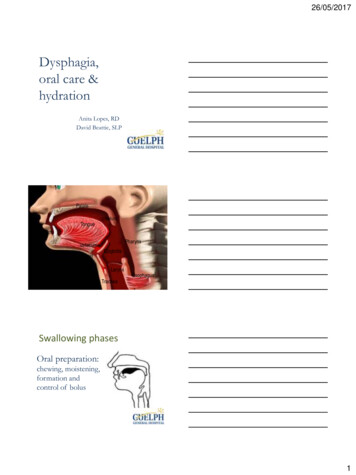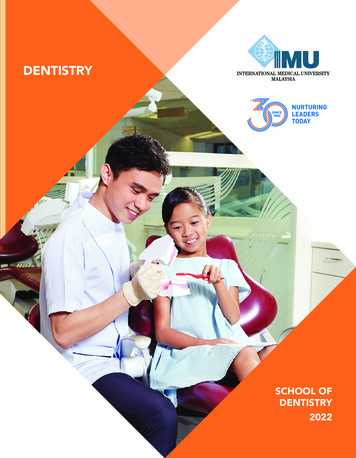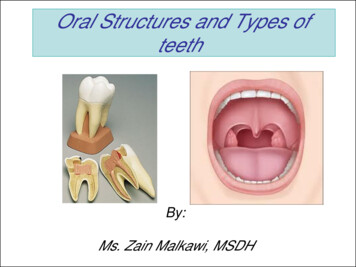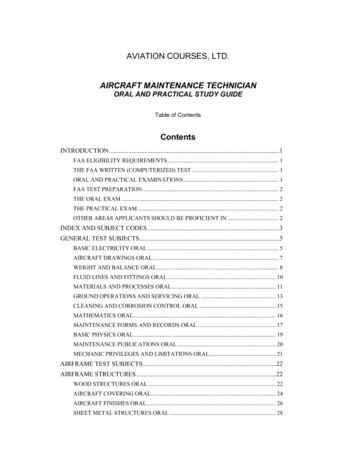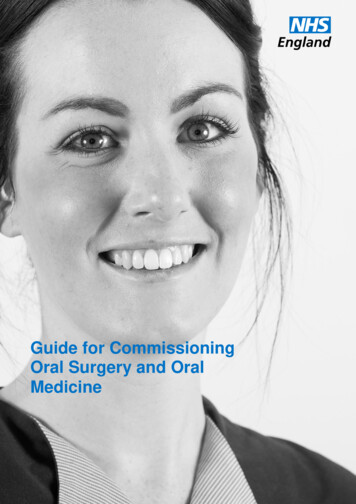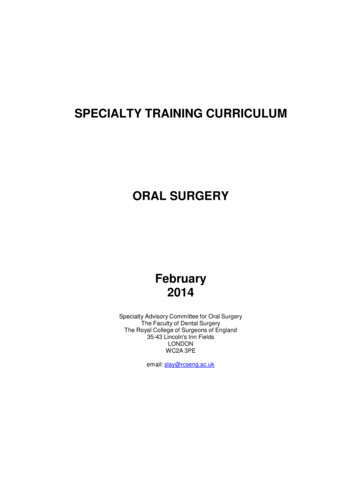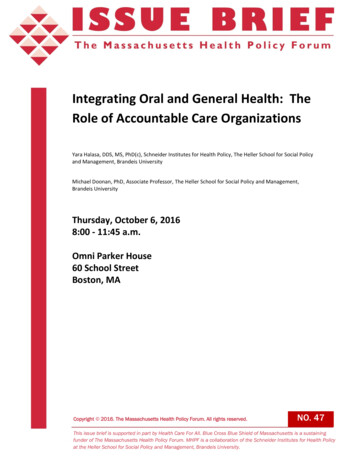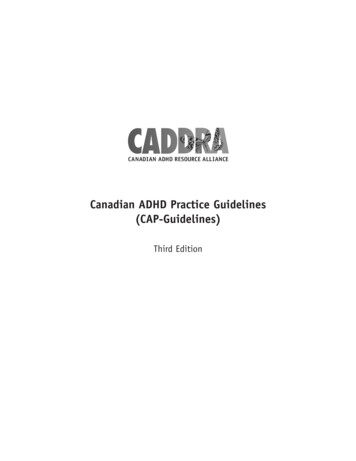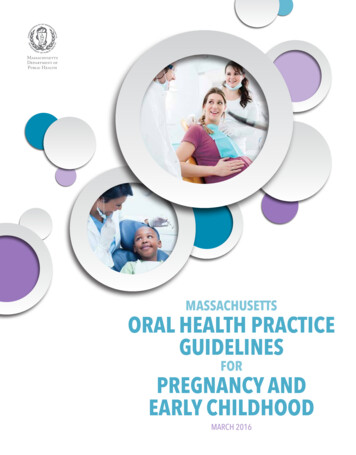
Transcription
MassachusettsDepartment ofPublic HealthMASSACHUSETTSORAL HEALTH PRACTICEGUIDELINESFORPREGNANCY ANDEARLY CHILDHOODMARCH 2016
INFORMATION FORPROVIDERS
MASSACHUSETTSORAL HEALTH PRACTICEGUIDELINESFORPREGNANCY ANDEARLY CHILDHOODMARCH 2016MassachusettsDepartment ofPublic Health
TABLE OF CONTENTSAcknowledgements 4Steering Committee and Advisory Committee5Executive Summary7Introduction 9Oral Health Practice Guidelines for Providers of Pregnant Women14Guidelines for Prenatal Providers15Guidelines for Oral Health Providers17Oral Health Practice Guidelines for Providers of Pediatric Patients20Guidelines for Pediatric Providers21Guidelines for Oral Health Providers25Appendices 29Appendix 1: Oral Health Policies and GuidelinesAppendix 2: Oral Health Curricula and ToolsAppendix 3: MassHealth Dental Program Fact SheetAppendix 4: List of Massachusetts Fluoridated Cities and Towns and ResourcesAppendix 5: Pyogenic Granuloma and Gingivitis during Pregnancy3032333638References 39InsertsFront Pocket: Information for ProvidersInsert 1: Medication Use During PregnancyInsert 2: Sample Referral Form for Pregnant Woman to Oral Health ProvidersInsert 3: Sample Referral Form for Children to Oral Health ProvidersBack Pocket: Information for PatientsInsert 4: Healthy Portion Sizes During PregnancyInsert 5: Eating Healthy During Pregnancy
ACKNOWLEDGEMENTSThis report was prepared by: Hafsatou Diop, Sunah Hwang, David Leader, HughSilk, Lucy Chie, Emily Lu, Sarah L. Stone, and Katherine Flaherty.Special thanks go to Ned Robinson-Lynch, former Director, Division of HealthAccess and Office of Oral Health Director; Dr. Linda A. Clayton, former Medical Director, Primary Care Clinician Plan, MassHealth Senior Associate MedicalDirector, Office of Clinical Affairs, UMass Medical School; and Dr. Brent Martin,Dental Director, Massachusetts Department of Public Health.We also wish to thank Dr. Michelle Dalal, Chair of the Massachusetts Chapterof the American Academy of Pediatrics Oral Health Committee and Vice Chairof the Massachusetts Medical Society Committee on Oral Health; Dr. Steven M.Ramos, Member of the Oral Health Committee at the Mass Medical Society;and Dr. Susan E. Manning, the Massachusetts CDC Maternal and Child HealthEpidemiologist Assignee, for their comprehensive review of this publication.Suggested Citation:Massachusetts Department of Public Health. Oral Health Practice Guidelinesfor Pregnancy and Early Childhood. Boston, MA; March 2016.To obtain additional copies of this report, please contact:Massachusetts Department of Public HealthBureau of Family Health and NutritionOffice of Data Translation250 Washington StreetBoston, MA 02108Telephone: 617-624-5764TTY: 617-624-5992This publication can be downloaded from the following rted by the Maternal and Child Health Services Block Grant, the Centers for Disease Control andPrevention Pregnancy Risk Assessment Monitoring System (PRAMS) Grant, and the Health Resourcesand Services Administration Grants to States to Support Oral Health Workforce Activities.4 Oral Health Practice Guidelines for Pregnancy and Early Childhood
STEERING COMMITTEELucy Chie, MD, MPH, FACOGSouth Cove Community Health Center/Beth Israel Deaconess Medical CenterBoston, MALinda A. Clayton, MD, MPHCommonwealth MedicineMassHealth Office of Clinical AffairsUniversity of MassachusettsQuincy, MAMarlene Barnett RDH, MPHProgram Coordinator, Office of Oral HealthMassachusetts Department of Public HealthBoston, MABrittany Brown RDH, BSDHProgram Coordinator, Office of Oral HealthMassachusetts Department of Public HealthBoston, MADaniel Chen, MPHTufts School of Public HealthBoston, MAHafsatou Diop, MD, MPHDirector, Office of Data TranslationBureau of Family Health and NutritionMassachusetts Department of Public HealthBoston, MAE. Jane Crocker, RDHImmediate Past President, Massachusetts Dental HygienistsAssociationBetter Oral Health for Massachusetts CoalitionBaldwinville, MASunah Susan Hwang, MD, MPHBoston Children’s HospitalBoston, MAMichelle Dalal, MDMassachusetts ChapterAmerican Academy of Pediatrics, Oral Health Committee/University of Massachusetts Medical School,Reliant Medical GroupMilford, MADavid Leader, DMD, MPHMassachusetts Dental Society/Tufts University School of Dental MedicineBoston, MABrent Martin, DDS, MBADental Director, Office of Oral HealthMassachusetts Department of Public HealthBoston, MANed Robinson-Lynch MA, LMHCFormer Director, Division of Health AccessMassachusetts Department of Public HealthBoston, MAHugh Silk, MD, MPHAmerican Academy of Family Physicians/Massachusetts Medical Society/University of Massachusetts Medical SchoolWorcester, MAADVISORY COMMITTEEKim Dever, MDSouth Shore HospitalSouth Weymouth, MATracy Erin, MDMassachusetts ChapterAmerican Congress of Obstetricians and Gynecologists/Massachusetts General HospitalBoston, MAEllen Factor, MSDirector of Dental Practice, Massachusetts Dental SocietySouthborough, MAKatherine Flaherty, ScD, MAKatherine Flaherty ConsultingFranklin, MAOmar Ghoneim, DDSCorporate Dental Director, Harbor Health Services/American Dental AssociationBoston, MAMyron Allukian, Jr., DDS, MPHPresident, Massachusetts Coalition for Oral HealthBoston, MATracy Gilman, CDA, MSMExecutive Director, MassHealth Dental Program/DentaQuestBoston, MACraig S. Andrade, LATC, RN, DrPHInterim Director, Division of Health AccessMassachusetts Department of Public HealthBoston, MABonnie Glass, RN, MSNChair, Massachusetts Perinatal Quality CollaborativeWestborough, MASteering Committee and Advisory Committee 5
Suzanne GottliebDirector of Family Initiatives, Massachusetts Department of PublicHealthBoston, MAYara A. Halasa, DDS, MS, MABrandeis UniversityWaltham, MAMehedia Haquem, DMDHarvard School of Dental Medicine/NYU Lutheran Medical CenterNew York, NYJanice HealeyMassachusetts Department of Public HealthBoston, MAAlicia High, MPHWIC/Health and Human Service Coordinator, MassachusettsDepartment of Public HealthBoston, MAHope Ricciotti, MDBeth Israel Deaconess Medical CenterBoston, MAJulian Robinson, MDBrigham and Women’s HospitalBoston, MAColeen Ryfa, CNMReliant Medical GroupFramingham, MAOlivia R. Sappenfield, MPHCSTE Applied Epidemiology Fellow, Massachusetts Department ofPublic HealthBoston, MASarah Lederberg Stone, PhD, MPHCSTE Applied Epidemiology Fellow, Massachusetts Department ofPublic HealthBoston, MAMalena Hood, MPHMassachusetts Department of Public HealthBoston, MAMary Tavares, DMD, MPHHarvard School of Dental Medicine/The Forsyth InstituteBoston, MAAngela F. Koenig, MD, MPHTufts University School of MedicineBoston, MANancy Topping-Tailby, MSWMassachusetts Head Start AssociationTaunton, MAMary LearyProgram and Policy Analyst, Massachusetts League of CommunityHealth CentersBoston, MAAlexis Travis, PhD, CHESChapter Director of Program Services, March of DimesNew England ChapterWestborough, MAEmily Lu, MPHPRAMS Coordinator, Massachusetts Department of Public HealthBoston, MAAna Vasilescu, MDMassachusetts ChapterAmerican Congress of Obstetricians and GynecologistsWinchester, MASusan Manning, MD, MPHCDC MCH Epidemiology Program Assignee, MassachusettsDepartment of Public HealthBoston, MAGlenn Markenson, MDDirector of Maternal Fetal Medicine, Baystate Medical CenterSpringfield, MAHubert Park, DMD, MPHTufts University School of MedicineBoston, MAMimi Pomerleau, DNP, RNC-OBPresident, Association of Women’s Health, Obstetric and NeonatalNurses/MGH Institute for Health ProfessionsBoston, MA6 Oral Health Practice Guidelines for Pregnancy and Early ChildhoodMaureen VosburghOral Health Coordinator, Massachusetts Head Start AssociationBelchertown, MAShannon Wells, MSWOral Health Affairs Manager, Massachusetts League of CommunityHealth CentersBoston, MAJohn Zdanowicz, DMDHarvard School of Dental MedicineBoston, MA
EXECUTIVE SUMMARYIn 2000, the Surgeon General’s report, Oral Health in America, identified oraldiseases as the “silent epidemic” affecting millions of children and adults in theUnited States.1 Since then, evidence of the effects of poor oral health on systemichealth, and social and economic well-being has accumulated. Universal access toaffordable dental care has been a priority for the Massachusetts Title V Maternal and Child Health Program since 2010, which has led to several initiatives toimprove oral health among pregnant women and young children.This document builds onIn 2013, the Title V Program, in collaboration with the Office of Oral Health atthe Massachusetts Department of Public Health (MDPH), convened a statewidesummit to lay a foundation for the integration of dental care into routine prenatalcare. The MDPH also endorsed efforts by Massachusetts Health Quality Partners to include oral health in its 2013 Perinatal Care Recommendations. An OralHealth Advisory Committee and work groups were subsequently convened byMDPH to develop oral health care practice guidelines for providers who care forpregnant women and young children.healthcare for pregnantstate and national efforts toeducate healthcare providersacross professions on oralwomen and young children.Massachusetts data show that women are much less likely to obtain oral healthcare during pregnancy than before pregnancy.2 The American Congress of Obstetricians and Gynecologists emphasizes that dental treatment is safe and desirableduring pregnancy.3 Obstetrical healthcare providers can educate their patients, whilecoordinating and collaborating with oral healthcare providers to improve women’s oral health. The section on prenatal oral health care highlights information onthe way that normal and pathologic aspects of pregnancy may affect oral healthand oral health care. Oral health practice guidelines for prenatal providers includeinstructions on how to assess oral health status, advise and educate patients, andrecommendations for referral and collaboration with oral healthcare providers.Similarly, specific recommendations for oral healthcare providers include assessment(health history, dental history, comprehensive examination including blood pressure and radiographs as appropriate), advice and education, and the provision of allnecessary treatment. Pregnancy in itself should not affect the type or quality of oralhealth care offered to pregnant patients. However, oral healthcare providers must beaware of medications which are acceptable for use during pregnancy (See Insert 1).Improving women’s oral health will also improve the health of their children bydecreasing transmission of decay causing bacteria. Dental caries (cavities) is themost prevalent chronic condition among children. All healthcare providers cancooperate to reduce caries risk for their young patients. Oral health practice guidelines for pediatric healthcare providers include recommendations for assessmentof oral health among children, including those with special health care needs.Appendices include risk assessment tools, information on fluoride use, prescribingguidelines, and a listing of Massachusetts communities that benefit from community water fluoridation. Community water fluoridation is the most cost effectivepreventive measure for tooth decay for all ages including pregnant women and it isthe foundation for better oral health.4 Healthcare providers may advise and educate with respect to diet and oral hygiene, and make a referral to a dental home. Adental home may be the office of a general dentist who feels comfortable treatingExecutive Summary 7
pregnant women and young children or a pediatric dentist who specializes in thetreatment of children (pedodontist). All healthcare providers may benefit fromreviewing the appendices that include a list of perinatal oral health guidelines andtools, and resources including information on MassHealth (Medicaid).This document builds on state and national efforts to summarize information inorder to educate healthcare providers across professions for the benefit of patients.The MDPH will publish this resource and maintain it as an electronic documentonline. The electronic version will be the most current.8 Oral Health Practice Guidelines for Pregnancy and Early Childhood
INTRODUCTIONORAL DISEASES: THE SILENT EPIDEMICOral health is essential to promote general health and well-being. In 2000, theSurgeon General’s report on oral health, Oral Health in America, identified oraldiseases as the “silent epidemic” affecting millions of children and adults in theUnited States.1 In its Healthy People 2020 health promotion and disease-prevention goals and objectives, the United States Department of Health and HumanServices recognized the importance of oral health across the lifespan. Oral healthis one of the 26 Healthy People 2020 Leading Health Indicators – children, adolescents and adults who visited the dentist in the past year. Additionally, Healthy People2020 includes 33 other objectives related to oral health, improving oral healthstatus, and increasing access to oral health prevention and treatment services.5During pregnancy, physical and physiological changes occur that can adverselyaffect the mouth. Gingivitis is the most common oral condition of pregnancy.6Left untreated, gingivitis may progress to periodontal disease which may destroyboth soft and hard tissues.7 Other oral conditions commonly occurring duringpregnancy include benign oral gingival lesions, tooth mobility, tooth erosion anddental caries (cavities).8 Pregnant women are at high risk for dental caries dueto increased exposure to gastric acid resulting from morning sickness early inpregnancy or an incompetent esophageal sphincter and gastric pressure later inpregnancy. Other causes of dental caries during pregnancy include inadequateamounts of fluoride, high intake of sugary food or beverages, and a lack of oralhealth care.9 Pregnant women who have caries may transmit caries-causing bacteria to their infants.9 Additionally, oral health disorders have been found to beassociated with a number of diseases affecting women across their lifespan, including cardiovascular disease, diabetes, Alzheimer’s disease, respiratory infections, andosteoporosis of the oral cavity.3Women are at risk for oralconditions during pregnancyand across the lifespan.Dental caries is the numberone chronic condition inchildren; oral health careis the most common unmethealth care need in children.Among children, dental caries is the number one chronic condition; it is five timesmore prevalent than asthma.3 According to the National Health and NutritionExamination Survey, “approximately 37% of children aged 2-8 years had experienced dental caries in primary teeth in 2011-2012” and “21% of children aged6-11 years had experienced dental caries in permanent teeth” during 2011-2012.10Untreated caries may cause pain, school absences, difficulty concentrating, andpoor appearance, all of which can adversely affect a child’s quality of life and ability to succeed academically and socially.11 Although a critical component of overallhealth, oral health care is the most common unmet health care need among children.12 According to the National Center for Health Statistics, 4.3 million U.S.children aged 2-17 years had unmet dental needs in 2010 because their familiescould not afford dental care.13 Under the Affordable Care Act (ACA), pediatricdental coverage is considered an essential benefit; the health insurance marketplaces created under the ACA must offer choice and availability of oral healthcoverage for everyone.14To effectively improve oral health among pregnant women and children, it isimportant to understand and address two contributing factors: health literacy andIntroduction 9
oral health disparities by race, ethnicity and income. Often, those with low levelsof health literacy are found among these same vulnerable populations.15,16Improving oral healthcare requires:»» Addressing disparities»» Increasing health literacy»» Using specialaccommodations andstrategiesChildren with Special Health Care Needs (CSHCN) are a group for whomoral health care can present additional challenges. These children are defined as“.those who have or are at increased risk for a chronic physical, developmental, behavioral, or emotional condition and who also require health and relatedservices of a type or amount beyond that required by children generally.”17,18About 18.3% of Massachusetts children aged 0-17 years met this definition in2009-2010.17 These children require special accommodations and strategies tosuccessfully receive prevention and treatment services in community settings.To address these issues across diverse, vulnerable populations, it is important forproviders to understand their populations, and provide culturally and linguisticallyappropriate care to meet their needs.18STATUS OF ORAL HEALTH AMONG PREGNANT WOMEN AND CHILDREN INMASSACHUSETTSAccording to data collected by MDPH using the Pregnancy Risk Assessment Monitoring System, PRAMS, there is opportunity to improve the oral health of pregnantwomen in Massachusetts. For example, among Massachusetts women who deliveredin 2011, about two-thirds reported having a dental cleaning during the 12 monthsbefore pregnancy, but only one-half reported cleanings during pregnancy.2Among the Massachusetts women studied, disparities in the proportion whoreceived dental cleanings during pregnancy were observed by age, race, ethnicity,and insurance status. Women aged 30-39 years old were more likely than youngerwomen to have their teeth cleaned during pregnancy (Figure 1). Among different racial/ethnic groups, White women were the most likely to have their teethcleaned during pregnancy; however, only 55.8% of these women had cleanings.For Asian and other women, about one-third had cleanings during pregnancy(Figure 2). Massachusetts women with private insurance were more likely to havetheir teeth cleaned during pregnancy (60.4%) than those with MassHealth (Medicaid) insurance (38.2%) (Figure 3).Figure 1. Prevalence of Teeth Cleaning During Pregnancy by Age, PRAMS, 20118070Percent6059.152.838.35039.3403020100 2020-2930-39Maternal Age (years)10 Oral Health Practice Guidelines for Pregnancy and Early Childhood40
Figure 2. Prevalence of Teeth Cleaning During Pregnancy by Race and Hispanic Ethnicity,PRAMS, Figure 3. Prevalence of Teeth Cleaning During Pregnancy by Insurance, PRAMS, assHealthOtherNoneHealth Insurance TypeThe oral health of Massachusetts children is better than that of children in otherstates, but there is opportunity for improvement. While Massachusetts rankedthe second lowest in the country for the proportion of third grade students withdental caries, more than 40% of Massachusetts third graders had dental cariesexperience. Almost one-fifth of third grade students had untreated tooth decay.18Additionally, there are significant oral health disparities among Massachusettschildren. While 85% of White parents reported the conditions of their children’steeth as excellent or very good, less than two-thirds of Black and Hispanic parentsreported the same. Compared to children without special health care needs, Massachusetts CSHCN were found to be less likely to have teeth in excellent or verygood condition (65%) than other children (73%).19NATIONAL EFFORTS TO ADDRESS ORAL HEALTH AMONG PREGNANTWOMEN AND CHILDRENSeveral national organizations have undertaken efforts to promote oral health amongpregnant women and children. They developed statements, guidelines, educationalmaterials, and tools to improve oral health. These include: the American Congressof Obstetricians and Gynecologists (ACOG), the American Academy of PediatricDentistry (AAPD), the American Academy of Pediatrics (AAP), the AmericanIntroduction 11
Academy of Periodontology, the American Academy of Physician Assistants(AAPA), the American College of Nurse-Midwives (ACNM), the Society of Teachers in Family Medicine (STFM), and the American Dental Association (ADA).In 2008, an expert panel convened by the U.S. Maternal and Child Health Bureau(MCHB) developed strategies for improving perinatal oral health. One strategywas to “promote the use of guidelines addressing oral health during the perinatal period and to disseminate guidelines to Maternal and Child Health andOral Health professionals.” This led to the development of a national consensusstatement in collaboration with ACOG and the ADA “Oral Health Care duringPregnancy: A National Consensus Statement,” as well as a Committee Opinionfrom ACOG “Oral Health Care During Pregnancy and Through the Life Span.”Several states including New York, California, South Carolina, and Washingtondeveloped statewide practice guidelines for perinatal oral health. The consensusstatement and other policies and guidelines, including website links where available, are included in Appendix 1.MASSACHUSETTS EFFORTS TO ADDRESS ORAL HEALTH FOR PREGNANTWOMEN AND CHILDRENIn 2010, the Massachusetts Title V program selected oral health as one of itspriorities, specifically – “Coordinating preventive oral health measures andpromoting universal access to affordable dental care.” The state’s performancemeasures include the “percentage of women with a recent live birth reportingthat they had their teeth cleaned recently (during pregnancy and one year beforeor after).” Additionally, the Massachusetts Health Quality Partners, a broadbased coalition of physicians, hospitals, health plans, purchasers, patient andpublic representatives, academics, and government agencies working together topromote improvement in the quality of health care services, now includes oralhealth screening and treatment for pregnant women in its Perinatal Care Recommendations and Guidelines, which can be found at 0Perinatal%20Guidelines.pdf and at ative%20Care%20Guidelines%202016.pdf.In order to identify opportunities for improvement in oral health care amongpregnant women and children, in 2011, MDPH sent surveys to Massachusettsfamily medicine physicians, obstetricians-gynecologists (OB-GYNS), dentists, anddental hygienists, with a 15% response rate. The responses suggest opportunities forimprovement. For example, family medicine physicians and OB-GYN respondentsdo not routinely refer their pregnant patients to oral healthcare professionals, andvery few of these providers give their patients educational materials on oral healthduring pregnancy. Higher proportions of dentists and dental hygienists provide thisinformation. The survey results also suggest that the knowledge of perinatal oralhealth and its relationship to diseases, such as cardiovascular disease and birth outcomes, is not consistent across providers. Subsequently, Massachusetts held an oralhealth summit and convened an advisory committee to develop practice guidelinesfor pediatric, prenatal and oral health providers for the oral health care of pregnantwomen and young children. A listing of the members of the Advisory Committeeand its work groups is provided after the Table of Contents.12 Oral Health Practice Guidelines for Pregnancy and Early Childhood
ROLE OF HEALTH CARE PROVIDERS IN IMPROVING ORAL HEALTH FORPREGNANT WOMEN AND CHILDRENEstablishing and maintaining good oral health during pregnancy and early childhood offers both opportunities and challenges. It requires education, coordinationand collaboration among pregnant women, children and their families, and theirprenatal care, pediatric and oral health care providers. Prenatal and pediatric providers, including physicians, nurses and medical assistants, can perform oral healthscreenings; provide oral health information, including prevention and treatment; andrefer to and collaborate with a number of different types of oral health providers.Typically, prenatal and pediatric providers refer to a general or pediatric dentistwhere the patients would also be seen by dental hygienists or dental assistants.These dental practitioners might then make subsequent referrals to dental specialists, such as periodontists, prosthodontists, endodontists, orthodontists, andoral and maxillofacial surgeons. Dental providers may be found in a number ofdifferent locations, including private practices, community health centers, dentalschools, hospitals and public health settings. Where they are available, communityhealth workers can be a valuable resource in facilitating access to dental servicesfor families.The practice guidelines that follow provide specific information to prenatal, pediatric and oral health providers about how to address the oral health care needs oftheir pregnant patients and children.HEALTH CAREPROVIDERS CANEDUCATE,COORDINATEANDCOLLABORATEIntroduction 13
ORAL HEALTH PRACTICEGUIDELINES FORPROVIDERS OFPREGNANT WOMENDespite the evidence that dental care during pregnancy, including prevention andtreatment, is safe and important to overall health, many pregnant women do not receiveoral health care. ACOG has issued a Committee Opinion to emphasize the importanceand safety of dental treatment during pregnancy.3The practice guidelines included in this section are consistent with guidance fromprofessional organizations. The guidelines provide detailed information about theprovision of dental care, including advice and education to pregnant women. In additionto these practice guidelines, there are a number of additional policies and guidelinesprovided in Appendix 1.It is important for oral health providers who care for pregnant women to be awareof the effects of pregnancy on oral health and systemic health. It is necessary tounderstand the physiologic changes throughout all three trimesters (1st – through13 weeks gestation; 2nd – 14 weeks through 27 weeks; and 3rd – 28 weeks to birth[40 weeks /-2 weeks]), as well as potential risks found during pregnancy. Normalphysiologic changes include increased blood volume and lower blood pressure inthe first trimester. Later in pregnancy, the uterus may put pressure on the vena cavanecessitating that the patient change position during dental treatment.About 7% of pregnant women have hypertension during pregnancy, 5-8% havepreeclampsia, less than 1% have eclampsia and 7% have gestational diabetes.20-22Medications/drugs can have significant effects on the fetus so it is important to knowwhat medications a woman is taking, and only prescribe those that are safe. A listing ofsafe/not safe antibiotics, analgesics, and anesthetics can be found in Insert 1. Certainpopulations, such as teens and women older than 35 years of age, women with multiplepregnancies, and those with systemic disease, such as HIV and Hepatitis C, are atincreased risk for pregnancy complications or adverse birth outcomes.Oral health and prenatal providers should work together as needed to providecoordinated prevention and treatment services.14 Oral Health Practice Guidelines for Pregnancy and Early Childhood
GUIDELINES FOR PRENATAL PROVIDERSASSESS ORAL HEALTH STATUS During the first prenatal visit, take an oral health history, including recentdental problems and dental care received. Sample questions for the oral healthhistory include: Do you have swollen or bleeding gums, a toothache, problems eating orchewing food, or other problems in your mouth? When was your last dental appointment? What was the purpose of your last dental appointment? Do you need help finding a dentist?Provide a brief oral examination by checking teeth and gums. For training inproper oral examination, see Appendix 2 for links to the Smiles for Life Course5 – Oral Health and the Pregnant Patient, and Course 7 – The Oral Examination training materials.Follow-up on any oral health problems, as needed, in subsequent prenatal andpost-partum visits.Document in the prenatal care record any oral health issues identified; status ofsmoking, alcohol and marijuana use; and history of dental services received.ADVISE AND EDUCATE Reassurance that fluoridation in community water is safe and effective.Counsel pregnant women about the following during prenatal visits: Importance of oral health during pregnancy, including visits at least every 6months. Importance of adhering to the oral health providers’ recommendations. Reassurance that dental care throughout pregnancy, including x-rays, dentalrestorations/extractions, pain medication and local anesthesia, is safe. Suggestions about ways to prevent tooth decay in pregnant women experiencing frequent nausea and vomiting:»» Eat small amounts of nutritious foods throughout the day. See Inserts 4and 5 for a list of suggested foods.»» Use a teaspoon of baking soda (sodium bicarbonate) in a cup of water asa rinse after vomiting to neutralize acid.»» Do not brush for one hour after vomiting as stomach acid can weakenthe enamel and cause hypersensitivity.»» Chew sugarless or xylitol-containing gum after eating, which preventstransmission of bacteria (Strep mutans) to their children reducing children’s risk of tooth decay.23»» Use gentle brushing with soft tooth brush and fluoride toothpaste toprevent damage to demineralized tooth surfaces.Include oral health in prenatal care classes offered to pregnant women.Community waterfluoridation is the most costeffective preventive measurefor tooth decay for all ages,including pregnant women,and it is the foundation forbetter oral health.Oral Health Practice Guidelines for Providers of Pregnant Women 15
REFER AND COLLABORATE Refer women with identified oral health problems in the first or subsequentvisits to oral health providers immediately.Develop referral procedures to oral health professional offices to facilitate timelyappointments.Complete a referral form for the oral health providers. A sample form adaptedfrom California Dental Society is the prov
the foundation for better oral health.4 Healthcare providers may advise and edu-cate with respect to diet and oral hygiene, and make a referral to a dental home. A dental home may be the office of a general dentist who feels comfortable treating This document builds on state and national

